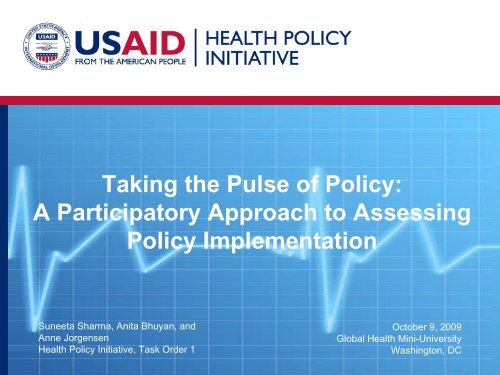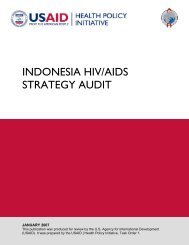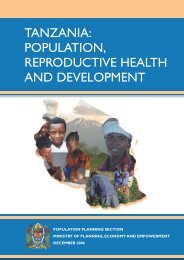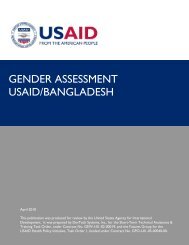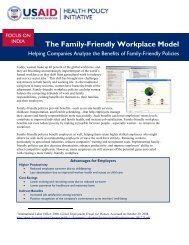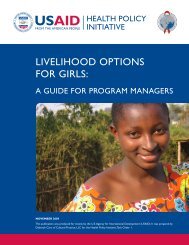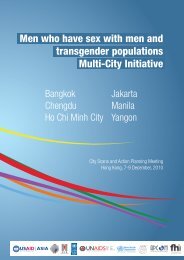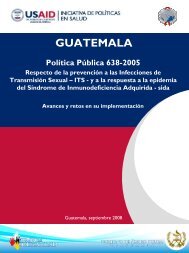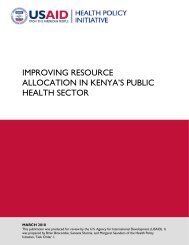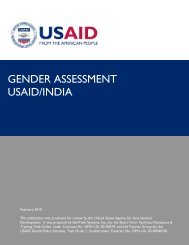Taking the Pulse of Policy: A Participatory Approach to Assessing ...
Taking the Pulse of Policy: A Participatory Approach to Assessing ...
Taking the Pulse of Policy: A Participatory Approach to Assessing ...
Create successful ePaper yourself
Turn your PDF publications into a flip-book with our unique Google optimized e-Paper software.
<strong>Taking</strong> <strong>the</strong> <strong>Pulse</strong> <strong>of</strong> <strong>Policy</strong>:<br />
A <strong>Participa<strong>to</strong>ry</strong> <strong>Approach</strong> <strong>to</strong> <strong>Assessing</strong><br />
<strong>Policy</strong> Implementation<br />
Suneeta Sharma, Anita Bhuyan, and<br />
Anne Jorgensen<br />
Health <strong>Policy</strong> Initiative, Task Order 1<br />
Oc<strong>to</strong>ber 9, 2009<br />
Global Health Mini-University<br />
Washing<strong>to</strong>n, DC
Session Agenda<br />
• Introduction<br />
• About <strong>the</strong> <strong>Policy</strong> Implementation Assessment Tool<br />
• Country Applications <strong>of</strong> <strong>the</strong> Tool<br />
• Advantages <strong>of</strong> Using <strong>the</strong> Tool<br />
• Q&A
What Is <strong>Policy</strong> Implementation<br />
<strong>Policy</strong> <strong>to</strong> Action Framework<br />
<strong>Policy</strong><br />
Process<br />
Data Analysis<br />
and Use<br />
<strong>Policy</strong><br />
Dialogue<br />
and Advocacy<br />
<strong>Policy</strong> &<br />
Strategy<br />
Development<br />
Operational<br />
Barrier<br />
Removal<br />
Leadership<br />
Mobilization<br />
Action<br />
Plan<br />
Resource<br />
Mobilization<br />
Implementation<br />
<strong>of</strong> Strategies<br />
Moni<strong>to</strong>ring<br />
and Evaluation<br />
Scale Up<br />
Action
Why Assess <strong>Policy</strong> Implementation<br />
• Accountability – hold policymakers/implementers<br />
accountable for achieving stated goals; reinvigorate<br />
commitment<br />
• Effectiveness – understanding barriers <strong>to</strong> policy<br />
implementation improves program delivery<br />
• Equity and quality – policy implementation is<br />
essential for ensuring equitable services, reducing<br />
inconsistencies among service providers<br />
We need <strong>to</strong> be “clearer about what works and what does not<br />
work <strong>to</strong> produce intended program outcomes in <strong>the</strong> actual<br />
practice setting” (Love, 2003)
About <strong>the</strong> <strong>Policy</strong> Implementation Assessment Tool<br />
• Objectives:<br />
– Assess <strong>the</strong> extent and nature <strong>of</strong> policy implementation<br />
– Identify facilita<strong>to</strong>rs for and barriers <strong>to</strong> policy implementation<br />
– Inspire dialogue and renewed commitment on <strong>the</strong> way forward<br />
• Format:<br />
– Two questionnaires (one for policymakers and one for<br />
implementers/o<strong>the</strong>r stakeholders)<br />
– Open-ended questions ga<strong>the</strong>r qualitative information, as well as<br />
close-ended questions and Likert-like scales<br />
– Same or similar questions in <strong>the</strong> two instruments <strong>to</strong> facilitate<br />
comparing perspectives <strong>of</strong> policymakers and implementers<br />
– Flexible: designed <strong>to</strong> be adapted <strong>to</strong> <strong>the</strong> policy/context
About <strong>the</strong> <strong>Policy</strong> Implementation Assessment Tool (cont.)<br />
7 Dimensions <strong>of</strong> <strong>Policy</strong><br />
Implementation <strong>Policy</strong> ‣ <strong>Policy</strong> Content, Its Formulation,<br />
and Dissemination<br />
Feedback<br />
‣ Feedback on<br />
Progress and<br />
Results<br />
Context<br />
‣ Social, Political, Economic,<br />
and Cultural Fac<strong>to</strong>rs<br />
POLICY<br />
IMPLEMENTATION<br />
Operations<br />
‣ Operations and<br />
Services (guidelines,<br />
training, capacity <strong>to</strong><br />
enact policies)<br />
Resources<br />
‣ Implementation Planning<br />
and Resources<br />
Leadership<br />
‣ Leadership Roles<br />
and Commitment<br />
Stakeholders<br />
‣ Multi-stakeholder Involvement<br />
in Implementation
Applying <strong>the</strong> Tool: Step-by-Step Process<br />
Select a<br />
policy<br />
Form a core<br />
country team<br />
Make<br />
decisions<br />
Adapt <strong>the</strong><br />
questionnaires<br />
Identify key<br />
informants<br />
Conduct<br />
Interviews/<br />
FGDs<br />
Analyze<br />
data<br />
Share findings/<br />
next steps
Country Examples:<br />
Guatemala and<br />
Uttarakhand, India<br />
A woman and her daughters waiting at <strong>the</strong> Health Center in<br />
Chichicastenango, Quiche, Guatemala. Pho<strong>to</strong> by Liz Mallas.<br />
An ASHA – Accredited Social Health Activist – in Uttarakhand,<br />
India. Pho<strong>to</strong> by Suneeta Sharma.
Guatemala: Background<br />
• Social Development and<br />
Population <strong>Policy</strong> (SDPP)<br />
(2001)<br />
• Broad policy covering five<br />
sec<strong>to</strong>rs: health, education,<br />
employment, etc.<br />
• Focused on <strong>the</strong> reproductive<br />
health component <strong>of</strong> <strong>the</strong><br />
health section<br />
• Assessment in 2006/07
Guatemala: Methodology<br />
• In-depth Interviews (n=36)<br />
– 7 policymakers<br />
– 29 implementers<br />
• Interviewees selected based on <strong>the</strong>ir knowledge <strong>of</strong><br />
and role in policymaking and implementation <strong>of</strong> <strong>the</strong><br />
SDPP<br />
• Sec<strong>to</strong>rs represented: public sec<strong>to</strong>r, civil society, and<br />
international donor community
Guatemala: Key Findings<br />
• Consensus on <strong>the</strong> importance <strong>of</strong> <strong>the</strong> policy<br />
• Lack <strong>of</strong> clarity among respondents about leadership<br />
and responsibilities for implementation<br />
• Lack <strong>of</strong> a cohesive implementation plan and M&E<br />
framework<br />
• Insufficient dissemination and capacity building <strong>to</strong><br />
support <strong>the</strong> policy implementation<br />
• Inability <strong>to</strong> access funds for implementation
Guatemala: Outcomes<br />
• Guatemala’s Congress formed a national<br />
Reproductive Health Observa<strong>to</strong>ry (March 2008)<br />
– Multisec<strong>to</strong>ral body including government, NGOs, universities<br />
– Moni<strong>to</strong>r <strong>the</strong> SDPP, Law on Social Development, Law on Universal<br />
Access <strong>to</strong> Family Planning, Law on Combating HIV and AIDS<br />
– Advocate for funding, including <strong>the</strong> 15% tax on alcoholic beverages<br />
that is intended <strong>to</strong> fund RH activities<br />
• Ministry <strong>of</strong> Public Health allotted an additional<br />
US$1.3 million <strong>to</strong> <strong>the</strong> RH program's 2008 budget<br />
• M&E indica<strong>to</strong>rs being developed <strong>to</strong> moni<strong>to</strong>r <strong>the</strong> SDPP<br />
• RH moni<strong>to</strong>ring boards established in three regions
Uttarakhand, India: Background<br />
• First state <strong>to</strong> adopt an<br />
integrated Health and<br />
Population <strong>Policy</strong> (2002)<br />
• Seeks <strong>to</strong> improve health,<br />
address inequities, and<br />
stabilize population growth<br />
• Outlines 28 strategic policy<br />
intervention areas<br />
• Assessment in 2008
Uttarakhand: Methodology<br />
• Location<br />
– Selected districts and blocks <strong>to</strong> represent<br />
<strong>the</strong> plains, mid-hills, and hilly region<br />
• Interviews (n=36)<br />
– 5 policymakers<br />
– 10 state implementers<br />
– 21 district implementers<br />
• Focus Group Discussions (n=32)<br />
– ANMs, ASHAs, AWWs, Panchayati raj<br />
representatives (179 participants)<br />
– Clients: Women and men from rural<br />
areas, urban slums, scheduled castes<br />
and tribes (208 participants)
Uttarakhand: Key Findings<br />
• High-level government<br />
commitment<br />
• Integrated health and<br />
population policy<br />
• Decentralization<br />
• Demand and knowledge<br />
increasing among <strong>the</strong><br />
population<br />
• Sufficiency <strong>of</strong> financial<br />
resources<br />
• Innovative approaches<br />
• Lack <strong>of</strong> leadership continuity<br />
• Human resource shortages<br />
• Inability <strong>to</strong> access and use funds<br />
• Under-utilization <strong>of</strong> <strong>the</strong> private<br />
sec<strong>to</strong>r and NGOs<br />
• Cumbersome moni<strong>to</strong>ring and<br />
limited data use<br />
• Limited systems for client feedback<br />
• Inadequate systems for intradepartment<br />
information sharing and<br />
dissemination forums
Uttarakhand: Outcomes<br />
• High-level policy dialogue with senior policymakers<br />
and <strong>of</strong>ficials (November 2008)<br />
• Formation <strong>of</strong> <strong>the</strong> <strong>Policy</strong> Revision Coordination<br />
Committee within <strong>the</strong> Uttarakhand Health and Family<br />
Welfare Society<br />
• <strong>Policy</strong> revision underway, with emphasis on:<br />
– Removing barriers <strong>to</strong> implementation<br />
– Equity (e.g., rural poor, urban slums, underserved hilly areas)<br />
– Data-driven strategies (e.g., interventions tailored <strong>to</strong> <strong>the</strong> plains and<br />
hills; addressing emerging health issues)<br />
• Program implementation plan <strong>to</strong> be developed
O<strong>the</strong>r Uses <strong>of</strong> <strong>the</strong> Tool<br />
• Guatemala: Public <strong>Policy</strong> 638-2005 “On <strong>the</strong><br />
prevention <strong>of</strong> STIs and response <strong>to</strong> <strong>the</strong> AIDS<br />
Epidemic”<br />
• El Salvador: National Strategic Plan on STIs, HIV,<br />
and AIDS, 2005–2010<br />
• Costa Rica and Panama: Planned applications for<br />
national HIV policies and plans
Advantages <strong>of</strong> Using <strong>the</strong> Tool<br />
Helps move from policy formulation <strong>to</strong> policy implementation<br />
Is flexible, should be adapted <strong>to</strong> <strong>the</strong> country context<br />
Is a systematic, yet user-friendly way <strong>to</strong> look at complex,<br />
dynamic processes<br />
Can complement quantitative indica<strong>to</strong>rs/data <strong>to</strong> explore <strong>the</strong><br />
“why” behind <strong>the</strong> numbers<br />
Renews commitment <strong>to</strong> a policy that may have been adopted<br />
a few years ago and is no longer at <strong>the</strong> <strong>to</strong>p <strong>of</strong> <strong>the</strong> agenda<br />
Promotes participa<strong>to</strong>ry approaches and dialogue <strong>to</strong> devise<br />
potential solutions <strong>to</strong> challenges (ownership, country-driven)
Key Take-a-way Messages<br />
Policies are living documents<br />
Policies need certain inputs <strong>to</strong> stay alive and healthy:<br />
Leadership, resources, participation, moni<strong>to</strong>ring, etc.<br />
The <strong>Policy</strong> Implementation Assessment Tool can help<br />
you “take <strong>the</strong> pulse” <strong>of</strong> <strong>the</strong> policy and diagnosis barriers<br />
and challenges<br />
Regular check-ups and renewed commitment can keep<br />
policies on track <strong>to</strong>ward achieving policy goals
Coming Soon: Tools You Can Use<br />
<strong>Policy</strong> Implementation Assessment Tool Guide<br />
Master questionnaires<br />
Master Excel datasheets for data entry<br />
Guiding questions for conducting <strong>the</strong> policy text<br />
analysis<br />
Examples from <strong>the</strong> country applications (e.g.,<br />
reports, advocacy briefs, and PPTs)
To learn more:<br />
www.healthpolicyinitiative.com<br />
policyinfo@futuresgroup.com<br />
Thank you!<br />
Any questions


